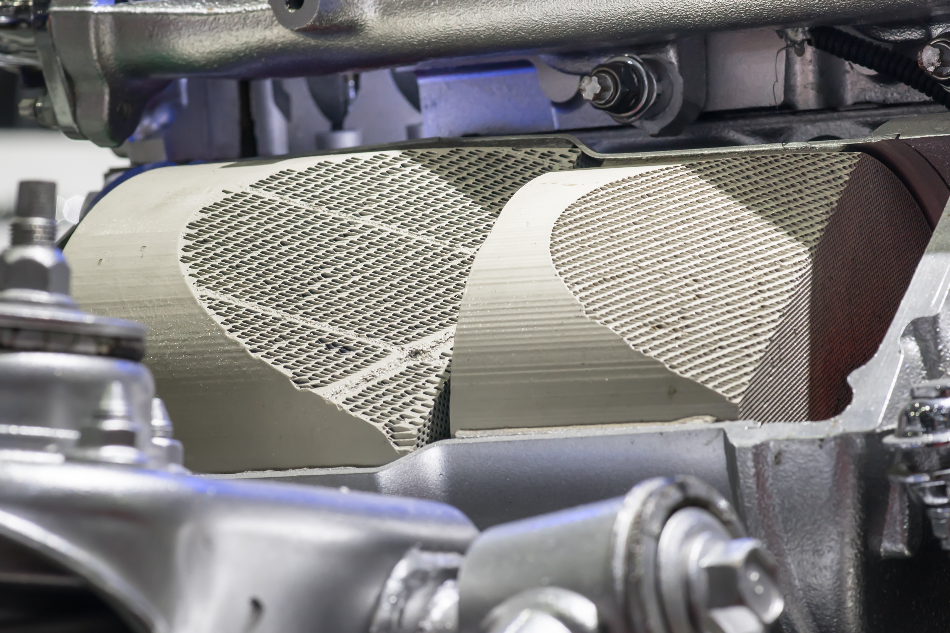A catalytic converter reduces the toxicity of nanoparticles released by petroleum-based engines. In January 2018, researchers from the University of Technology in Tampere, Finland, took atmospheric measurements near traffic.

Image Credit: Thanaphat Kingkaew/Shutterstock.com
Their findings showed the NCA emissions (nanocluster aerosol) of cars and other vehicles to be about 2-3*10^15 NCA. Taking the average passenger car’s fuel consumption in Finland, the researchers calculated emissions per kilometer to be in the range of 10^14 particles. The EURO 6 limit for solid nanoparticles above 23nm in diameter is 6*10^11#/km. Numbers do not lie, and the Tampere team concluded that NCA emission levels were 100-1000 times higher than the regulatory level. This study was conducted in Finland, arguably one of the most environmentally friendly countries in the modern era. Nanoparticle and other emissions in the US and China are far higher, which is why catalytic converters have become ever more important in our race to protect the planet from ourselves.
Modern converters
The toxic by-products produced when an engine burns fuel is funneled into the catalytic converter, where chemical reactions turn them into water and Co2. The most common catalyst still used is platinum, but platinum is a rare element, making it costly to use. Back in 2010, scientists developed a new method to coat platinum nanoparticles with a porous silica layer. This layer provided an energy barrier that held the platinum in place even at high temperatures. It prevented aggregation – a common issue with the older converters – but more importantly, it helped to maintain the catalytic activity.
How they affect
Converters have become increasingly efficient due to our understanding of how nanoparticles interact with the chemicals produced by modern engines. A study at DESY’s X-ray source, PETRA III determined that catalytic converters become more efficient when using nanoparticles with many edges. Instead of relying on nanoparticles with flat surfaces, a many edged surface can capture and transform more of the toxic by-products without using as much platinum. Noxious carbon monoxides are converted into Co2 on the surface of noble metal nanoparticles, but a larger number of edges on the nanoparticles increases the converter efficiency.
On older converters, the nanoparticles are attached to small sections of the substrate, sticking together to form the complex structure required to catalyze. The converters would use nanoparticles that all align in different directions, increasing the reaction rate once a certain oxygen concentration is reached. However, the problem comes when the O2 concentration goes above the optimum level, leading to an oxide layer build-up that impedes reaction.
Modern converters use nanoparticles because of the greater surface area they have for a given amount of material, on which the reaction can take place. O2 is unable to form a closed film along the surface edges between the faces of nanoparticles, leading to catalytic reactivity on the edges being higher. As toxic gases pass over the many-edged platinum nanoparticles, the gas molecules land on the surface, triggering a reaction that is faster and more efficient than older converters. Other advances have also been made.
Scientists from the Karsruhe Institute of Technology (KIT) found that the nanoparticle size and oxidation rates of the platinum components during vehicular operation can be specifically modified. Their experiments highlighted a dynamic catalytic converter surface that reacts sensitively to external impacts including exhaust gas composition. The scientists were able to adjust the size and state of the nanoparticles on the converter to increase reaction.
The road ahead
Cars produce a high amount of particulate matter. The nanoparticles generated during braking and from engine exhaust can be reduced with the aid of the new catalytic converters. Whilst effects differ from converter to converter, if the technology is adopted globally, the future is looking more positive from an emissions perspective.
References
How many nanoparticles does your car emit? – Arimodus - 2018
https://airmodus.com/many-nanoparticles-car-emit/
Successful synthesis of nanomaterial that improves catalytic converter efficiency – Phys.org - 2017
https://phys.org/news/2017-05-successful-synthesis-nanomaterial-catalytic-efficiency.html
Edges and corners increase efficiency of catalytic converters – Science Daily - 2018
https://www.sciencedaily.com/releases/2018/03/180326110051.htm
Dynamic catalytic converters for clean air in the city – Nanowerk - 2017
https://www.nanowerk.com/nanotechnology-news/newsid=48442.php
Nanotechnology promises better catalytic converter – Physics.org - 2010
https://phys.org/news/2010-09-nanotechnology-catalytic.html
Disclaimer: The views expressed here are those of the author expressed in their private capacity and do not necessarily represent the views of AZoM.com Limited T/A AZoNetwork the owner and operator of this website. This disclaimer forms part of the Terms and conditions of use of this website.